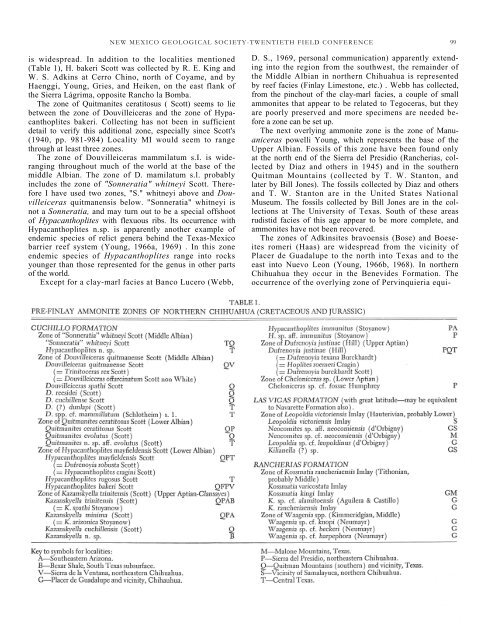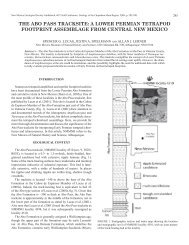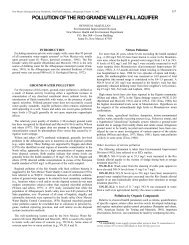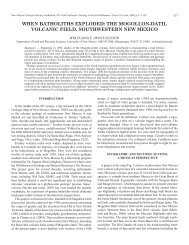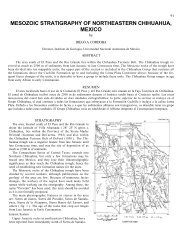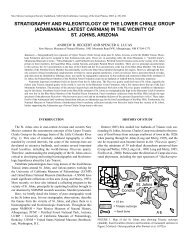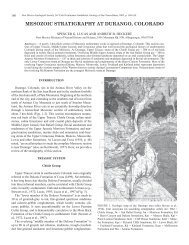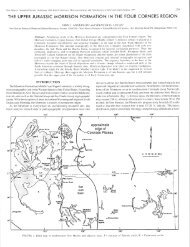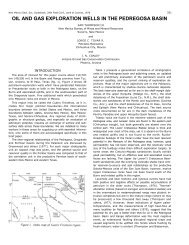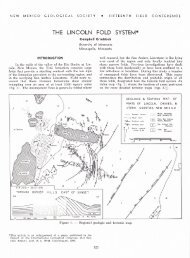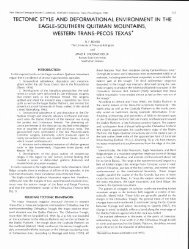Ammonite zones of northern Chihuahua - New Mexico Geological ...
Ammonite zones of northern Chihuahua - New Mexico Geological ...
Ammonite zones of northern Chihuahua - New Mexico Geological ...
Create successful ePaper yourself
Turn your PDF publications into a flip-book with our unique Google optimized e-Paper software.
NEW MEXICO GEOLOGICAL SOCIETY-TWENTIETH FIELD CONFERENCE 99<br />
is widespread. In addition to the localities mentioned<br />
(Table 1), H. bakeri Scott was collected by R. E. King and<br />
W. S. Adkins at Cerro Chino, north <strong>of</strong> Coyame, and by<br />
Haenggi, Young, Gries, and Heiken, on the east flank <strong>of</strong><br />
the Sierra Lágrima, opposite Rancho la Bomba.<br />
The zone <strong>of</strong> Quitmanites ceratitosus ( Scott) seems to lie<br />
between the zone <strong>of</strong> Douvilleiceras and the zone <strong>of</strong> Hypacanthoplites<br />
bakeri. Collecting has not been in sufficient<br />
detail to verify this additional zone, especially since Scott's<br />
(1940, pp. 981-984) Locality MI would seem to range<br />
through at least three <strong>zones</strong>.<br />
The zone <strong>of</strong> Douvilleiceras mammilatum s.I. is wideranging<br />
throughout much <strong>of</strong> the world at the base <strong>of</strong> the<br />
middle Albian. The zone <strong>of</strong> D. mamilatum s.l. probably<br />
includes the zone <strong>of</strong> "Sonneratia" whitneyi Scott. Therefore<br />
I have used two <strong>zones</strong>, "S." whitneyi above and Douvilleiceras<br />
quitmanensis below. "Sonneratia" whitneyi is<br />
not a Sonneratia, and may turn out to be a special <strong>of</strong>fshoot<br />
<strong>of</strong> Hypacanthoplites with flexuous ribs. Its occurrence with<br />
Hypacanthoplites n.sp. is apparently another example <strong>of</strong><br />
endemic species <strong>of</strong> relict genera behind the Texas-<strong>Mexico</strong><br />
barrier reef system (Young, 1966a, 1969) . In this zone<br />
endemic species <strong>of</strong> Hypacanthoplites range into rocks<br />
younger than those represented for the genus in other parts<br />
<strong>of</strong> the world.<br />
Except for a clay-marl facies at Banco Lucero (Webb,<br />
D. S., 1969, personal communication) apparently extending<br />
into the region from the southwest, the remainder <strong>of</strong><br />
the Middle Albian in <strong>northern</strong> <strong>Chihuahua</strong> is represented<br />
by reef facies (Finlay Limestone, etc.) . Webb has collected,<br />
from the pinchout <strong>of</strong> the clay-marl facies, a couple <strong>of</strong> small<br />
ammonites that appear to be related to Tegoceras, but they<br />
are poorly preserved and more specimens are needed before<br />
a zone can be set up.<br />
The next overlying ammonite zone is the zone <strong>of</strong> Manuaniceras<br />
powelli Young, which represents the base <strong>of</strong> the<br />
Upper Albian. Fossils <strong>of</strong> this zone have been found only<br />
at the north end <strong>of</strong> the Sierra del Presidio (Rancherias, collected<br />
by Diaz and others in 1945) and in the southern<br />
Quitman Mountains (collected by T. W. Stanton, and<br />
later by Bill Jones). The fossils collected by Diaz and others<br />
and T. W. Stanton are in the United States National<br />
Museum. The fossils collected by Bill Jones are in the collections<br />
at The University <strong>of</strong> Texas. South <strong>of</strong> these areas<br />
rudistid facies <strong>of</strong> this age appear to be more complete, and<br />
ammonites have not been recovered.<br />
The <strong>zones</strong> <strong>of</strong> Adkinsites bravoensis (Bose) and Boeseites<br />
romeri (Haas) are widespread from the vicinity <strong>of</strong><br />
Placer de Guadalupe to the north into Texas and to the<br />
east into Nuevo Leon (Young, 1966b, 1968). In <strong>northern</strong><br />
<strong>Chihuahua</strong> they occur in the Benevides Formation. The<br />
occurrence <strong>of</strong> the overlying zone <strong>of</strong> Pervinquieria equi-


